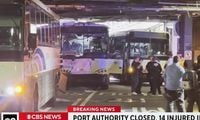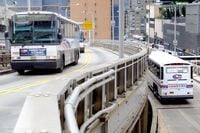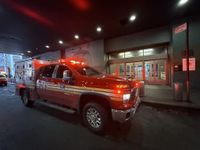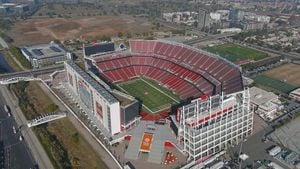On the morning of Wednesday, July 2, 2025, a multi-bus collision at the Port Authority Bus Terminal in Midtown Manhattan caused significant disruption, injuring 12 to 14 people and halting NJ Transit operations during the peak rush hour. The crash, involving three NJ Transit buses, occurred around 6:15 a.m. on the entrance ramps to the terminal, specifically on the third floor above 9th Avenue between West 40th and West 41st Streets.
According to Steve Burns, spokesperson for the Port Authority of New York and New Jersey, the collision involved three NJ Transit buses and resulted in 12 people sustaining minor injuries, with one individual transported to a hospital for further evaluation. The Fire Department of New York (FDNY) reported that 14 people were injured, with 13 taken to area hospitals and one refusing medical attention at the scene. Fortunately, all injuries were non-life-threatening.
The crash caused immediate chaos for commuters. NJ Transit suspended bus service into and out of the Port Authority Bus Terminal, rerouting buses to Secaucus Junction, Newark Penn Station, and Hoboken Terminal. Trains made additional stops at Secaucus to accommodate displaced passengers, and ferry services by New York Waterway at Port Imperial stepped in, cross-honoring NJ Transit bus tickets and rerouting certain bus lines, including the 158 and 159, to the Port Imperial Ferry Terminal in Weehawken. Additionally, PATH transit honored NJ Transit passes at Hoboken, Newark Penn Station, and 33rd Street stations.
The crash’s timing compounded the morning’s challenges, as the Lincoln Tunnel experienced nearly hour-long delays by 8 a.m., and traffic on Midtown streets surrounding the terminal slowed to a crawl. NJ Transit rail riders also faced delays entering Penn Station, further complicating the commute for thousands of Garden State passengers.
Initially, NJ Transit announced the terminal was closed, but the Port Authority later clarified that the bus terminal remained open, with only NJ Transit bus service suspended. The express bus lane (XBL) ramp, a critical artery feeding buses into the terminal, was closed following the crash but reopened by 9:38 a.m., allowing bus operations to resume with residual delays.
NJ Transit CEO Kris Kolluri confirmed that 15 passengers and two employees sustained minor injuries in the crash. Emergency crews remained at the scene well into the morning rush, assisting with cleanup and managing traffic control. The cause of the crash remains under active investigation, although sources close to the inquiry suggest that one of the bus drivers may have suffered a medical emergency, potentially contributing to the collision.
The Port Authority Bus Terminal, known as the world’s busiest bus terminal, handles approximately 1,850 buses during morning peak hours—nearly three times the volume the exclusive bus lane was originally designed to accommodate. The terminal’s complex system of ramps and narrow lanes can make navigation challenging, especially during rush hour when buses move bumper-to-bumper. Cedrick Fulton, who managed the facility from 1998 to 2004, noted that minor errors or crashes at moderate speeds can cause outsized disruptions due to the terminal’s design.
Fulton recalled rare instances when bus operations completely halted, including during Hurricane Floyd preparations in 1999 and the Northeast blackout of 2003, underscoring how unusual it is for the terminal to suspend service. He also highlighted ongoing construction and the need for improvements, noting that just last week, the Port Authority board approved a $4.8 billion first phase of a $10 billion plan to rebuild and expand the terminal. This ambitious project aims to increase bus bays, widen corridors, and create two-lane ramps to improve traffic flow and reduce the impact of breakdowns or accidents.
The July 2 crash adds urgency to these plans, illustrating the vulnerability of the current infrastructure. The incident not only disrupted thousands of commuters but also exposed how a single event can ripple through the region’s transit network, affecting buses, trains, ferries, and road traffic.
As the investigation continues, officials urge commuters to check service alerts and explore alternate routes. NJ Transit has committed to cross-honoring tickets across multiple transit modes to ease passenger inconvenience. Meanwhile, emergency responders and transit authorities remain vigilant to prevent further incidents and improve safety measures.
While the Port Authority Bus Terminal has long been a critical hub connecting New Jersey and Manhattan, the recent crash serves as a stark reminder of the challenges facing one of the nation’s busiest transit centers. The upcoming expansion promises to modernize the facility, but until then, commuters must navigate the complexities of a system stretched to its limits.






